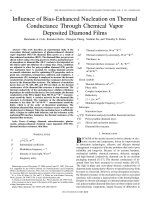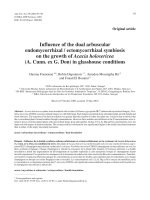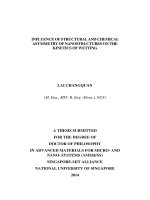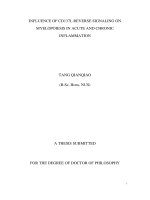Influence of different growing media on mass production of Aschersonia aleyrodis, a fungal pathogen of citrus black fly
Bạn đang xem bản rút gọn của tài liệu. Xem và tải ngay bản đầy đủ của tài liệu tại đây (253.14 KB, 9 trang )
Int.J.Curr.Microbiol.App.Sci (2020) 9(5): 1583-1591
International Journal of Current Microbiology and Applied Sciences
ISSN: 2319-7706 Volume 9 Number 5 (2020)
Journal homepage:
Original Research Article
/>
Influence of Different Growing Media on Mass Production of
Aschersonia aleyrodis, a Fungal Pathogen of Citrus Black Fly
D. N. Bhosale1, Y. V. Ingle2* and H. B. Goramnagar3
1
Department of Plant Pathology, Dr. PDKV, Akola-444104, India
2
AICRP on Fruits, Dr. PDKV, Akola, Maharashtra, India
3
RFRS, Katol Dist. Nagpur, India
*Corresponding author
ABSTRACT
Keywords
Aschersonia
aleyrodis, mass
production, growth
and sporulation
Article Info
Accepted:
15 April 2020
Available Online:
10 May 2020
Aschersonia aleyrodis (Webber) one of the fungal entomopathogens utilized as a
bio-control agent and was reported as the cause of epizootics amongst citrus black
fly populations. The present study was aimed to find out cost effective suitable
medium for mass multiplication of Aschersonia aleyrodis. Influence of synthetic,
semi-synthetic culture media and food grains as solid substrate on growth and
sporulation of A. aleyrodis was studied under laboratory condition. Amongst the
different culture media tried, Potato dextrose agar and Asthana and Hawker’s
media produced good growth (9.0 cm and 8.90 cm respectively) and abundant
sporulation (2.31 x 106 and 2.12 x 106 spore/ml respectively) of A. aleyrodis within
short span of time. Among the six food grains, sorghum as solid substrate resulted
in highest spore (3.40 x 107 spore/ml) production and next best was maize (3.32
x107 spore/ml) proved to support the production of maximum spore load of tested
fungus whereas rice and barley were least preferred substrate in producing the
spores (1.44 x 107 spore/ml and 1.13 x 107 spore/ml respectively.
Introduction
Among
the
entomopathogenic
fungi,
Aschersonia
aleyrodis
(Webber)
are
important entomogenous fungi that have been
found predominately in tropical and
subtropical habitats and are known to be
pathogenic to Aleyrodidae and Coccidae
family insect pests like black fly, white fly
and scale insects (Petch,1921). However,
mass production of entomogenous fungi is
important steps in successful utilization of
entomopathogenic fungi as biocontrol agents.
The production of conidia dependents upon
the culture medium and its nutritional source
which plays important role in determining the
quantity of conidia in terms of spore
germination.
1583
Int.J.Curr.Microbiol.App.Sci (2020) 9(5): 1583-1591
Few attempts have been made to multiply the
mycopathogen using semi-synthetic media
and solid substrates. N. rileyi has been mass
produced on crushed sorghum + 1% yeast
extracts (Vimala Devi and Prasad, 2003).
Patel (1990) reported that sorghum was the
best substrate for growth and sporulation of
M. anisopliae. Bhadauria et al., (2012)
reported that pea amended media produced
maximum biomass of the Beauveria bassiana
while Sabouraud’s dextrose broth produced
significantly higher spore production of the
fungi. Mycelia growth and sporulation on
synthetic and semi-synthetic media are
essential biological characteristics of fungi,
including A. aleyrodis. However, very meager
information available with the nutritional
requirements and mass production of
Aschersonia aleyrodis. In order to further
facilitate the physiological study of this
fungus and its application in bio-control more
information is required. The first step is to
increase the biomass and sporulation in an
artificial culture.
At present to promote the growth and
sporulation of entomopathogens solid and
liquid state fermentation procedure was
adopted. Solid state fermentation was used for
the production of aerial conidia (Rousson et
al., 1983) and submerged liquid fermentation
for the production of blastospores, which are
short lived, and hydrophilic (Romback, 1989).
However, the most viable mass production
technologies include making use of a diphasic
strategy in which the fungal inoculum is
produced in liquid culture, which is further
utilized for inoculating the solid substrate(s)
for conidia production (Burges and Hussey,
1981). Therefore, the present study was
undertaken to evaluate synthetic and semi
synthetic culture media (solid and liquid) and
food grains substrate for the mass production
of Aschersonia aleyrodis to make it very cost
efficient and easily adaptable with locally
available indigenous substrates.
Materials and Methods
The present study was conducted in the
Department of Plant Pathology, Dr. Panjabrao
Deshmukh Krishi Vidyapeeth, Akola and
AICRP on Fruits, Dr. PDKV, Akola. The
black fly nymph that appeared to be mycosis
was collected from Pala village of Morshi
Tahsil of Amravati district. The mycosis
insect samples brought to the laboratory and
pathogen was isolated on PDA media.
Multiplication on different media
Pure culture subjected to grown on ten
different solid media in Petri plates as well on
broth media (100 ml) in 250 conical flasks
and incubated for 15 days in BOD at 25 ±
1°C. The media used for the study were
Potato dextrose agar, Sabouraud’s maltose
agar + yeast extract (1%), Sabouraud’s
dextrose agar + yeast extract, V8 juice
medium, Barley carrot yeast extract medium,
Malt extract agar medium, Barner’s medium,
Czapek’s medium, Corn meal agar and
Asthana and Hawker’s medium. Each
treatment was replicated thrice. Observations
on radial mycelia growth, average number of
days required for sporulation and spore count
were recorded on agar media and dry mycelia
weight were recorded on broth media.
Multiplication on different grain substrate
Mass multiplication is an essential aspect for
the production and commercialization of
biological product. Following substrates were
used for mass production. Clean and dry
sorghum, wheat, bajra, maize, rice, and barely
were crushed in the household mixer for
about 30 second to make small pieces.
Crushed grains (100 g) added to 250 ml
conical flask and 95 ml sterile distilled water
was added. Then soaked for 24 hrs and
autoclaved for 20 minutes at 1.04 kg/cm2.
After cooling, each flask was inoculated with
1584
Int.J.Curr.Microbiol.App.Sci (2020) 9(5): 1583-1591
6 mm circular agar disc from 15 days old
fungal culture grown on PDA plates, and
shaken well to disperse the inoculum. The
conical flaks were incubated in BOD
incubator at 25 ± 1°C. After 15 days, fungal
mass along with spores from each flask was
harvested along with the substrate and
crushed after drying under laminar air flow
for 12 hr.
The spore powder along with grain carrier
was suspended in 50 ml sterile 0.05% Tween
80 solution and mixed thoroughly using a
sterile glass rod. The suspension was filtered
through Whatman No. 1 filter paper and
conidial
yield
was
counted
using
haemocytometer (Pandey and Kana, 2008).
significance (8.3, 7.38, and 7.22, cm
respectively). Slow and minimum growth
(2.18 cm) was observed in Sabouraud’s
dextrose agar media among the tested media.
Number of days required for sporulation
Figure 1 showed that all the ten media have
expressed different performance in respect to
number of days required for sporulation. PDA
media was significantly effective over other
media and sporulated within 8.69 days.
Thereafter, Asthana and Hawker’s media
supported minimum days (9.49) for
sporulation. Sabouraud’s dextrose agar (SDA)
initiated sporulation after 14.01 days.
Effect of spore count
Statistical analysis
The data collected from the experiments were
subjected to analysis of variance for different
treatments.
Fisher's
protected
critical
difference (CD) test was used to indicate the
difference between the treatments at the
probability level of p < 0.01 following the
procedure described by Gomez & Gomez
(1984).
All the ten media performed differently in
exhibiting varied intensity of spore production
(Fig. 1). Highest spore load to the extent of
2.31 × 106 spore/ml of fungal suspension was
obtained in PDA medium which was
statistically significantly superior over all the
media. Asthana and Hawkers, Czapek’s, Malt
extract medium also favoured for good
sporulation. Least spore production (1.0 x 106
spore/ml) was observed in SDA media.
Results and Discussion
Effect of different solid media on growth
and sporulation of A. aleyrodis
Effect on radial mycelia growth
It is evident from (Fig. 1) that significant
differences were found in radial growth of A.
aleyrodis. Almost all the media were more or
less supported the growth of A. aleyrodis.
Significantly more growth was noticed on
PDA medium (9.0 cm) followed by Asthana
and Hawker’s media showed 8.90 cm radial
growth. Other media viz; Barely carrot yeast
extract (BCY), Barners, Czpeck’s, supported
the growth but all were at equal level of
A. aleyrodis had an ability to utilize the
specific substrates for their growth and
multiplication. Maximum mean colony
diameter, spore count and minimum number
of days required for sporulation was observed
on Potato dextrose agar media followed by
Asthana and Hawkers media as synthetic
media followed by Barley Carrot Yeast
extract media as semi synthetic media.
Next effective medium was Barners, and
Czpeck’s
medium.
Minimum
colony
diameter, spore count and maximum days
required for sporulation observed in
Sabouraud’s dextrose agar medium (2.18 cm;
1.00 × 106 spore/ml) respectively.
1585
Int.J.Curr.Microbiol.App.Sci (2020) 9(5): 1583-1591
These findings resembled with the results
reported by Homrahud et al., (2016) and Lima
et al., (2017), who reported that PDA medium
was most suitable for culturing Aschersonia.
Homrahud et al., (2016) reported that
Sabouraud’s dextrose agar medium produced
statistically less number of conidia of
Aschersonia placenta than that of Potato
dextrose agar and Sabouraud’s maltose agar
medium which is consistent with the present
findings.
The main constituent of Potato dextrose agar
medium is dextrose and potato which might
have utilized as source of carbon resulted in
profuse growth. Similarly Berger (1921)
cultured A. aleyrodis on sweet potato agar and
obtained higher spore load (8 x 106
spore/cm2).
Effect of different broth media on growth
and sporulation of A. aleyrodis
Effect on growth
Among the ten different broth media
evaluated, maximum dry mycelial weight of
A. aleyrodis noted in Potato dextrose broth
(Figure 2) and observed as a best supporting
medium that yielded (0.60 g)) dry mycelial
weight followed by Asthana and Hawker’s
broth (0.58 g). Other broth viz; Barley carrot
yeast extract broth, Barner’s and Czpeck’s
broth also supported the growth (0.54, 0.54,
0.51 g respectively) and relatively equal level
of significance.
Malt extract broth (0.45 g) and Sabouraud’s
maltose broth (0.41 g) showed at par level of
significance. The broth V8 juice and corn
meal broth showed less growth 0.24 and 0.23
g respectively as compare to other media. The
minimum dry mycelial weight was reported
on the Sabouraud’s dextrose broth i.e. (0.04
g).
Number of days required for sporulation
In particular broth media number of days
required for sporulation recorded to the tune
of 8.52 to 14.20 days in respective media
(Figure 2). Less number of days required for
sporulation of Aschersonia recorded in Potato
dextrose broth media i.e. 8.52 days.
Second best media was Asthana and
Hawker’s media influence the sporulation
within 8.56 days and which is at par with
barely carrot yeast extract broth (8.79 days)
and Barner’s media (8.92 days). Maximum
number of days required for sporulation
reported in SDA media (14.20 days).
Effect of spore count
Unlike solid media, broth media also
exhibiting varied degree of spore production.
Maximum spore count (2.28 x 106 spore/ml)
noted in Potato dextrose broth medium
(Figure 2).
Second best medium was found Asthana and
Hawker’s yielded 2.17 x 106 spore/ml. Least
spore production (1.03 x 106 spore/ml)
registered in Sabouraud’s dextrose broth
media.
In general Potato dextrose broth medium and
Asthana and Hawker’s broth medium are
supporting the fungal dry biomass, minimum
days for sporulation and maximum spore
load. The broth like Sabouraud’s dextrose
have been found to be less effective in
supporting dry mass and sporulation of
Aschersonia.
In liquid media growth and sporulation was
slow and more time required as compared to
solid media. These results are in line with the
earlier studies carried out by Kulat et al.,
(2002) and Hamrahud et al., (2016).
1586
Int.J.Curr.Microbiol.App.Sci (2020) 9(5): 1583-1591
Table.1 Effect of different solid media on growth and sporulation of A. aleyrodis
SN
Media
1
2
3
4
5
6
7
8
9
10
Potato dextrose agar
Sabouraud’s maltose agar
Sabouraud’s dextrose agar
V8 juice
Barely carrot yeast extract
Malt extract
Barners
Czapek’s
Corn meal agar
Asthana and Hawkers media
CD (P=0.01)
Mycelial
Growth in cm
(10 DAI )
9.00
5.72
2.18
3.65
8.30
6.75
8.23
8.13
3.20
8.90
0.30
No. of days for
sporulation
Spore count
(× 106 spore/ml)
8.69
11.85
14.01
12.26
9.72
11.12
10.01
10.08
13.20
9.49
0.031
2.31
1.25
1.00
1.23
1.81
1.44
1.59
1.49
1.05
2.12
0.024
DAI days after inoculation
Table.2 Effect Of different broth media on growth and sporulation of A. aleyrodis
SN
1
2
3
4
5
6
7
8
9
10
Media
Potato dextrose broth
Sabouraud’s maltose broth
broth
Sabouraud’s dextrose broth
V8 juice broth
Barely carrot yeast extract
broth
Malt extract broth
Barners broth
Czapek’s broth
Corn meal broth
Asthana and Hawkers broth
SE(m)±
CD(P=0.01)
No. of days for
sporulation
Spore count
(× 106 spore/ml)
8.52
11.58
2.28
1.25
0.04
0.24
0.54
14.20
13.17
8.79
1.03
1.20
1.78
0.45
0.54
0.51
0.23
0.58
9.13
8.92
9.03
9.52
8.56
1.39
1.54
1.48
1.07
2.17
0.003
0.017
0.024
0.11
0.0052
0.024
Mycelial dry
weight g
(15 DAI )
0.60
0.41
DAI days after inoculation
1587
Int.J.Curr.Microbiol.App.Sci (2020) 9(5): 1583-1591
Table.3 Effect of different food grain substrates on conidial production of A. aleyrodis
SN
1
2
3
4
5
6
Grain substrate
Sorghum
Maize
Wheat
Bajara
Rice
Barely
F ‘ test
SE(m)±
CD (P=0.01)
Spore count 20 DAI (×107 spore/ml)
3.40
3.32
3.25
2.80
1.44
1.13
Sig.
0.018
0.081
*average of four replications DAI days after inoculation
Fig.1 Effect of different solid media on growth and sporulation of A. aleyrodis
Fig.2 Effect of different broth media on growth and sporulation of A. aleyrodis
1588
Int.J.Curr.Microbiol.App.Sci (2020) 9(5): 1583-1591
Fig.3 Effect of different food grain substrates on conidial production of A. aleyrodis
Effect of different food grain substrates on
conidial production of A. aleyrodis
Among the grain substrates tested, sorghum
(3.40 × 107 spores/ml) and maize (3.32× 107
spores/ml) were found to support the
production of maximum spore load of A.
aleyrodis. Wheat as substrate measured spore
count 3.25 × 107 spores/ml was noticed after
20 days of incubation. (Figure 3 and Plate 3).
Bajra also measured spore count 2.80 × 107
spores/ml whereas rice and barely were least
preferred substrate in producing the spores
1.44 × 107 and 1.13 × 107 spores/ml
respectively.
Previous workers have also successfully used
agro-wastes such as crushed sorghum maize,
wheat, rice bran, bajra and bagasse singly and
along with supplementation for mass
multiplication
of
Nomuraeya
rileyi,
Metarhizium, Beauveria and Parcilomyces
(Vimala Devi and Prasad, 2003; Pandey and
Kana, 2008; Puzari et al., 1997 and
Gopalkrishnan et al., 1999). However, a
perusal of literature reveals that these results
might be providing information for the first
time as sorghum and maize grains supported
maximum sporulation of A.aleyrodis. This
might be due to crushed sorghum and maize
will help to provide more surface area for
growth of fungus and make available
substrates for hydrolyzing enzymes. Crushed
sorghum proved to be a good source of
soluble starch. Hydrolysis of starch in
sorghum releases higher amount of glucose
and maltose (Preez et al., 1985).
Moreover, sorghum grains containing higher
amount of dextrose (1.8%) and amino acids
such like glutamic acid (Anonymous 1991)
possibly favoured the sporulation. In
particular A. aleyrodis, for mass production,
solid substrate fermentation (food grains) is
most admirable method as compare to
artificial media. The benefit of this method is
that spores are easily harvested and can be
used to prepare formulations. Furthermore,
their foremost advantages are use of easily
available agriculture based and biodegradable
substrate. This allows the cheaper and safe
exploitation of this fungus in insect pest
management.
1589
Int.J.Curr.Microbiol.App.Sci (2020) 9(5): 1583-1591
Acknowledgement
All sort of assistance rendered by ICARAICRP on Fruits scheme for the above study
is gratefully acknowledged.
References
Anonymous, 1991, Hand Book of Cereal
Science and Technology, (Eds. Klans, J.
E. Lovenz and K. Karel). Marcel
Dekkar Inc., New York. pp 175.
Berger, E. W., 1921, Natural enemies of scale
insects and whiteflies in Florida.
Florida. Quart. Bull. Fla. Stn. Plant
Board 5, 141.
Bhaduria Bhanu Pratap, Puri, S. and Singh P.
K., 2012, Mass production of
entomopathogenic
fungi
using
agricultural products. The Bioscan,
7(2):229-232.
Burges, A. D. and Hussey, N. W.,1981,
Microbial Control of Insect Pests and
Mite, Academic Press, London, pp.
161-167.
Gomez, K. A.and Gomez, A. A., 1984,
Statistical Procedures for Agricultural
Research, second ed. John Wiley and
Sons, New York, NY, USA.
Gopalakrishnan, C., Anusuya, D. and
Narayanan, K., 1999, In vitro
production
of
conidia
of
entomopathogenic fungus Parcilomyces
farinosus. Entomology. 24: 389-392.
Homrahud, D., Uraichuen S. and Attathom,
T.,2016, Cultivation of Aschersonia
placenta Berkeley and Broom and its
efficacy for controlling Parlatoria
ziziphi. Agriculture and Natural
Resources, 50: 179-185.
Kulat, S. S., Zade, N. N., Peshkar, L. N. and
Varhade, S. S., 2002, Influence of
different culture media on the growth
and sporulation of Metarhizium
anisopliae (Metsch.) Sorokin. J. Biol.
Control., 16(2): 177 –179.
Lima, B.M.G.V., Almida, J.E.M., Moreira,
J.O.T, Santos, L.C., Bittencourt, M.A.,
2017,
Entomopathogenic
fingi
associated with citrus black fly
(Alerocanthus wogulmi) in southern
Bahia. Arg. Insta. Biot., 84(1):1-3.
Pandey, K., and Kana, K. R.., 2008, Effect of
different grains as solid substrates on
sporulation, viability and pathogenicity
of
Metarhizium
anisopliae
(Metschnikoff) Sorokin. J. Biol.
Control, 22(2): 369-374.
Patel, K. C., Yadaw, D.V., Dube, H. C.and
Patel, R. J. .1990, Laboratory and mass
production studies with Metarhizium
anisopliae. Annu. Biol., 6: 135-138.
Pitch, T.,1921, Studies on entomopathogenic
fungi: The genera Hypocrella and
Aschersonia. Annals of the Royal
Botanic Gardens Peradeniya, 7:167278.
Preez, J. C., Jong, F.P., Botes, J. and Lategon,
T. M., 1985, Fermentation alcohol from
grain sorghum starch. Biomass, 8, pp
101 – 117.
Puzari, K. C., Sharma, D. K. and Saranka, L.
K., 1997, Media for mass production of
Beauveria bassiana. J. Biol. Control,
11: 96-100.
Romback, M. C., 1989, Production of
Beauveria
bassinaa
conidia
in
submerged culture. Entomophaga, 5:
45-52.
Rousson, S., Rainbautt, M., and Lonsane, B.
K., 1983, Zymotics a large scale
fermenter design and evaluation. Appl.
Biochem. Biotechnol, 42: 161-167.
Vimala Devi and Prasad, S., 2003, Conidia
production of the entomopathogenic
fungus N. rileyi and its evaluation for
control of S. litura on Ricinus
communis. J. Invertebrate Pathology,
63:145-150.
1590
Int.J.Curr.Microbiol.App.Sci (2020) 9(5): 1583-1591
How to cite this article:
Bhosale. D. N., Y. V. Ingle and Goramnagar. H. B. 2020. Influence of Different Growing
Media on Mass Production of Aschersonia Aleyrodis, a Fungal Pathogen of Citrus Black Fly.
Int.J.Curr.Microbiol.App.Sci. 9(05): 1583-1591. doi: />
1591









